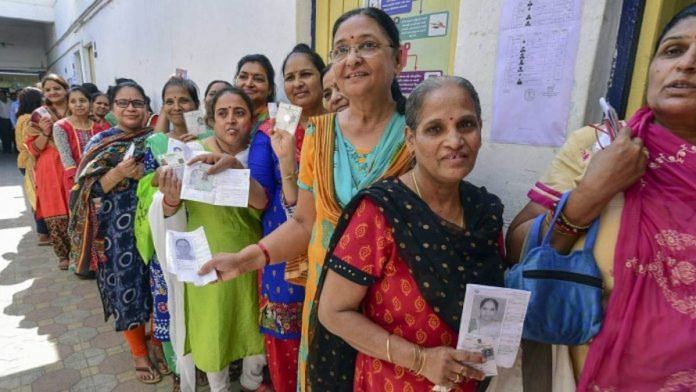New Delhi: The turnout in 67.6 percent of constituencies that have polled so far have fallen from 2019, data released by the Election Commission of India (ECI) showed, despite the number of people voting in absolute terms having gone up by 2 crore.
The low attendance in 253 of the 374 seats that the ThePrint analysed flies in the face of the ECI’s efforts to bring down “youth and urban apathy”, while also targeting several pockets where voting has been traditionally low.
Out of the remaining 169 seats of total 543, only 164 will go to polls. In Assam, four seats — Darrang-Udalguri, Diphu, Kaziranga, and Sonitpur — were created during the delimitation exercise and did not go to polls. Additionally, the Surat seat in Gujarat did not see voting, as the sitting BJP MP was the only candidate in the fray.
And while these 164 seats are yet to vote, the trend is already clear.
There are as many as seven seats where the dip was in double digits. In Nagaland, the overall number of voters plunged by 25.3 percentage points and in Madhya Pradesh’s Sidhi, 13 percentage points. In Madhya Pradesh, three seats witnessed a fall in double digits — Khajuraho (-11.31 percentage points), Rewa (-11.01 percentage points) and Shahdol (-10.07 percentage points).
Uttar Pradesh’s Mathura (-11.68 percentage points) and Kerala’s Pathanamthitta (-10.9 percentage points) also saw major dips.
Major states — where at least 15 seats have gone to polls — have seen a decline in turnout in all four phases. Across four phases, there were 12 major states.
All 38 seats that have been polled in Kerala and West Bengal, saw a decline in turnout. In Gujarat and Bihar, where voting has taken place in 44 of a combined 65 seats, two (one in each state) saw a decline. In Tamil Nadu nearly 90 percent (or 35 of 39) seats saw voters keeping away.
Two key states in the Hindi heartland witnessed a significant decline — Uttar Pradesh (in 33 of 39 seats that have gone to polls) and Rajasthan (in 22 of 25 seats that saw polling) — as did Maharashtra (15 of 35 seats that saw voting) and Madhya Pradesh (23 of 29 seats).
Karnataka and Telangana, however, bucked this trend, since only five out of a combined total 45 seats saw a decline in the turnout.
In absolute numbers, too, fewer people came out to vote in 102 of 374 seats compared to 2019. In Nagaland and Jammu’s Lok Sabha seats, almost 2 lakh fewer voters turned up to vote.
If we compare the present numbers to 2014 — when Prime Minister Narendra Modi was elected for the first time — as many as 220 constituencies have seen a decline in turnout percentage. This despite the fact that 6.4 crore more people have already voted so far.
Most of these seats seeing the decline fall in Tamil Nadu (35 of a total 39), Uttar Pradesh (30 of a total 39 seats that went to polls), Gujarat (23 of 25), West Bengal (all its 18 seats) and Maharashtra (16 of 35 that saw voting).
Not all bad news
There are, however, success stories too. In Srinagar, which has seen calls for boycott over the past three decades, 4.8 lakh more voters turned out compared to 2019.
Meanwhile, Telangana’s Malkajgiri and Chevella, too, saw a combined rise of 3.5 lakh in number of voters.
There were 153 other seats where, despite a decline in turnout percentage, more voters exercised their mandate. For instance, in Gujarat’s Dahod, voter turnout declined by over 7 percentage points, yet nearly 48,000 more voters cast their vote this election season.
Bihar’s Araria saw a decline in turnout by nearly 3 percentage points but saw 80,000 more voters. The state’s Supaul also saw a decline in turnout by 2.1 percentage points but a rise in the number of voters of 1.1 lakh.
Compared to 2019, 72.8 million more electors were added to the country’s electorate, according to the ECI. Ahead of the elections, 968.8 million registered voters were in the electoral roll.
There are only five states where over 10 seats have seen a rise in voter turnout so far — Andhra Pradesh, Karnataka, Telangana, Maharashtra and Chhattisgarh. In Chhattisgarh, all 11 seats saw an increased turnout percentage.
The most dramatic rise was in Srinagar, which saw its highest turnout percentage after 1996 — a rise of 24.06 percentage points compared to the last Lok Sabha polls.
Meghalaya’s capital Shillong also saw a rise of 8.32 percentage points. Four other seats saw a boost in turnout by 5 percentage points or more. Three of them were in Telangana — Nagarkurnool, Mahbubnagar, Zahirabad — and Raichur in Karnataka.
Does a higher or a lower voter turnout say anything about election results? Most political analysts and psephologists do not believe so, given their data.
In 2018, psephologists Milan Vaishnav and Johnathan Guy had written in a paper: “What our analyses (of data) do reveal is that, despite the popularity of the notion that citizens come out to the polls in greater numbers when they are motivated to punish the incumbent government, three decades of electoral data present a more ambiguous picture.”
They added that voter turnout, according to data, was not necessarily pro- or anti-incumbent but rather that the relationship between these two variables was likely shaped by the specific context at hand.
“Similar analyses using national election data conducted by other researchers tell a comparable story: changes in voter turnout are not highly informative of future electoral outcomes,” they said.
(Edited by Tikli Basu)
Also read: BJP is no longer as rattled as it was earlier in the 2024 election campaign






